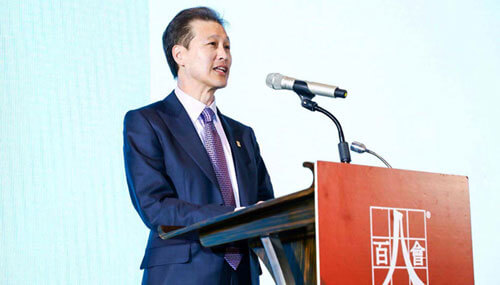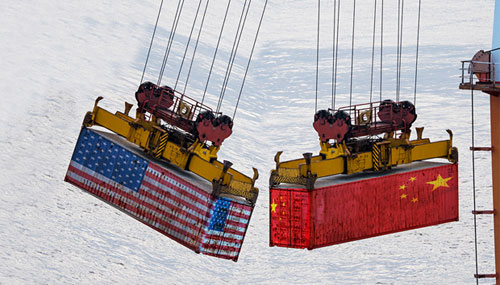U.S.-Asia Business
Dominic's Take: Getting Down to Business—Putting the US-China Relationship Back on Track
By Dominic Ng

Chinese reforms and “phase one” trade deal open an opportunity to rebuild the US-China relationship. Business leaders must step up to sustain that momentum, says Dominic Ng, CEO of East West Bank.
With the sealing of a limited deal to halt the trade war, we may finally be seeing a de-escalation of hostility in U.S.-China relations. Under a phase one trade deal, both sides committed to halting further tariff hikes, giving time for business leaders to take stock of the damage and begin planning ahead for the future. As negotiators turn their attention to phase two, we must take the opportunity to step forward and encourage politicians to put the relationship back on track for the sake of both countries’ economic well-being.
A mounting toll
Both countries have been battered by the trade war. Under pressure from tariffs, Chinese exports to the U.S. fell 12% year-on-year in the first half of 2019, hurting Chinese businesses and American consumers alike. It’s easy to forget that trade with China has made Americans richer by making the products they buy cheaper. A recent study found that China’s entry to the WTO led to a 7.6% reduction in manufacturing prices in the U.S. As tariffs have gone back up, American wallets have started to feel lighter.
U.S. businesses are hurting too, with exports to China falling 19%. Beyond causing immediate pain, this could also have long-term consequences for U.S. exporters, who are losing market share in agriculture, energy, and even lumber, where U.S. hardwood exports to China in June 2019 were half of what they were a year prior. Meanwhile, Russian lumber suppliers have gained ground in China, threatening to supplant American exporters in the long term.
Investors are also less certain than ever. Bilateral direct investment flows are down nearly 70% since 2016. Little wonder, since the U.S. is opening investigations into long-completed cross-border deals like Bytedance’s acquisition of video app Musical.ly, now TikTok. New rules are tightening foreign investment in a diffuse set of so-called “emerging technologies.” Some are even calling for restricting cross-border flows of stocks and bonds, just as China has put liberalization of its own capital markets into higher gear.
The consequences of a full-blown trade war and disruptive U.S.-China decoupling is already having an impact on the global economy. The IMF’s global growth forecast for 2019 is a paltry 3.0 %—the lowest since the global financial crisis. The global economy is already under strain, but if all announced tariffs go into effect, global GDP would fall by an additional $700 billion—equivalent to annual output from Vietnam, New Zealand, Ukraine and Morocco combined.

“We must take the opportunity to step forward and encourage politicians to put the relationship back on track for the sake of both countries’ economic well-being.”
Those who call upon American companies to leave China fail to recognize how costly and difficult uprooting factories and supply chains would be. It’s no coincidence that China spends a hundred times more on infrastructure than its neighbor, Vietnam, a dynamic country that is nonetheless no replacement for the Chinese market. China, a country with 13 of the world’s largest ports, is not an easy partner to replace.
Positive reform momentum in China
These are all compelling reasons to put the U.S.-China relationship back on track, and positive Chinese reform momentum is reinforcing the need to re-engage.
In 2011, China had a total of 117 industries marked as prohibited or restricted for foreign investors. By 2019, it had transitioned to a negative list of restricted sectors containing only 40 industries. A new Foreign Investment Law, which will take effect in 2020, will further level the playing field for foreign investors and introduce new rules to protect intellectual property rights of foreign investors.
China is demonstrably starting to deliver on its promised reforms, and these efforts are showing in many independent metrics. For example, China’s efforts to cut red tape have led the World Bank to upgrade China’s Ease of Doing Business ranking, most recently from 45th to 31st – even higher than France.
The most important testament to Beijing’s reform efforts is that many foreign businesses are doubling down on their investments in China. Thanks to China abolishing joint venture requirements in electric vehicle manufacturing, Tesla has built a brand-new factory in Shanghai without being forced to work with a local partner or give up any technology. Beijing is also lifting controls on financial institutions, allowing JPMorgan to buy a controlling stake in a Chinese securities firm for the first time. With the conditions for better IP protection in place and joint venture requirements reduced, Germany’s BASF recently broke ground on a new $10 billion wholly-owned petrochemical complex in China.
"The consequences of a full-blown trade war and disruptive U.S.-China decoupling is already having an impact on the global economy."

Business leaders must act
For decades, business leaders have played an important role in promoting constructive and mutually beneficial U.S.-China relations. The recent disenchantment that business leaders felt over unresolved issues in the economic relationship led the business community to push for a tougher stance with China. But with reforms now underway, it is time for the business community to resume its crucial role as a moderator of the U.S.-China relationship, or else we risk further escalation at great cost to both countries and the global economy.
To start, business leaders can do a better job informing policymakers about the costs of continued hostility. After all, decoupling with China would not come cheap. What are the costs of protectionist economic policies on both sides that hurt competition? What is the cost of restricting fruitful research collaborations, ranging from climate change to breakthrough medicine? The business community can—and must—deliver these answers to get the relationship back on track.
Business leaders are also best positioned to keep both sides honest. We will see firsthand whether China’s Foreign Investment Law is delivering on its promises of preventing forced technology transfer, or if Chinese businesses are being treated fairly in the United States. When things are going the right direction, we should make sure these achievements are recognized and encourage even greater progress. When they are not, we must speak up.
This is a critical opportunity for business leaders. We must be advocates for de-escalation and engagement, and not let the voices of division and discord sow continued disintegration. The U.S., China, and the world will be better off for it.
This editorial first appeared on the South China Morning Post.

